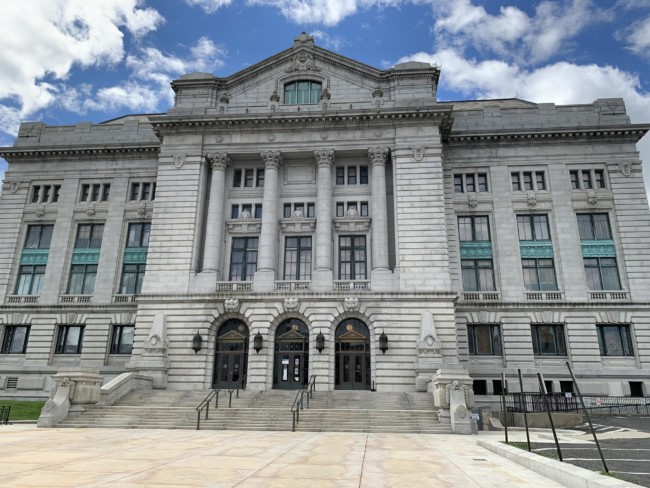When you stop and smell the flowers along the waterfront at Exchange Place or trek through Hoboken Terminal, do you ever wonder the history beneath your feet? It may not occur to you daily, but there’s plenty of history in Hudson County to discover just outside your door. We invite you to take a walk back-in-time and follow along with our curated self-guided walking tours that highlight local “treasures” and history to help you truly discover different neighborhoods throughout Hoboken and Jersey City. First up, Journal Square!
Getting There
Journal Square {JSQ} is a neighborhood, business center and transit hub in Jersey City situated at the intersection of Bergen Avenue and Kennedy Boulevard in Jersey City. You can travel to Journal Square via public transportation by the PATH train or bus. If you’re feeling adventurous, it takes about 30 minutes to walk from the Grove Street PATH Station in downtown Jersey City or 45 minutes from the Hoboken Transit Terminal to the JSQ Path.
The History of the Name
The area was dubbed “Journal Square” as the Jersey Journal headquarters was right in the square between 1911 to 2013. The Jersey Journal is a local newspaper that ran its first edition in 1867 under the name Evening Journal. It wasn’t until 1909 that the newspaper became known at the Jersey Journal and covered more cultural and political events throughout Hudson County. The headquarters, which opened in Jersey City in 1911, is no longer in Journal Square but it’s presence {aka the red sign} lives on.
Journal Square Today
The area contains the county’s social services, the Court House, the Division of Motor Vehicles, and a few chain stores, with some newer restaurants. For a full guide on JSQ today, check out our article, Exploring Jersey City: Journal Square.
Stop #1: JSQ PATH Plaza {1 PATH Plaza}
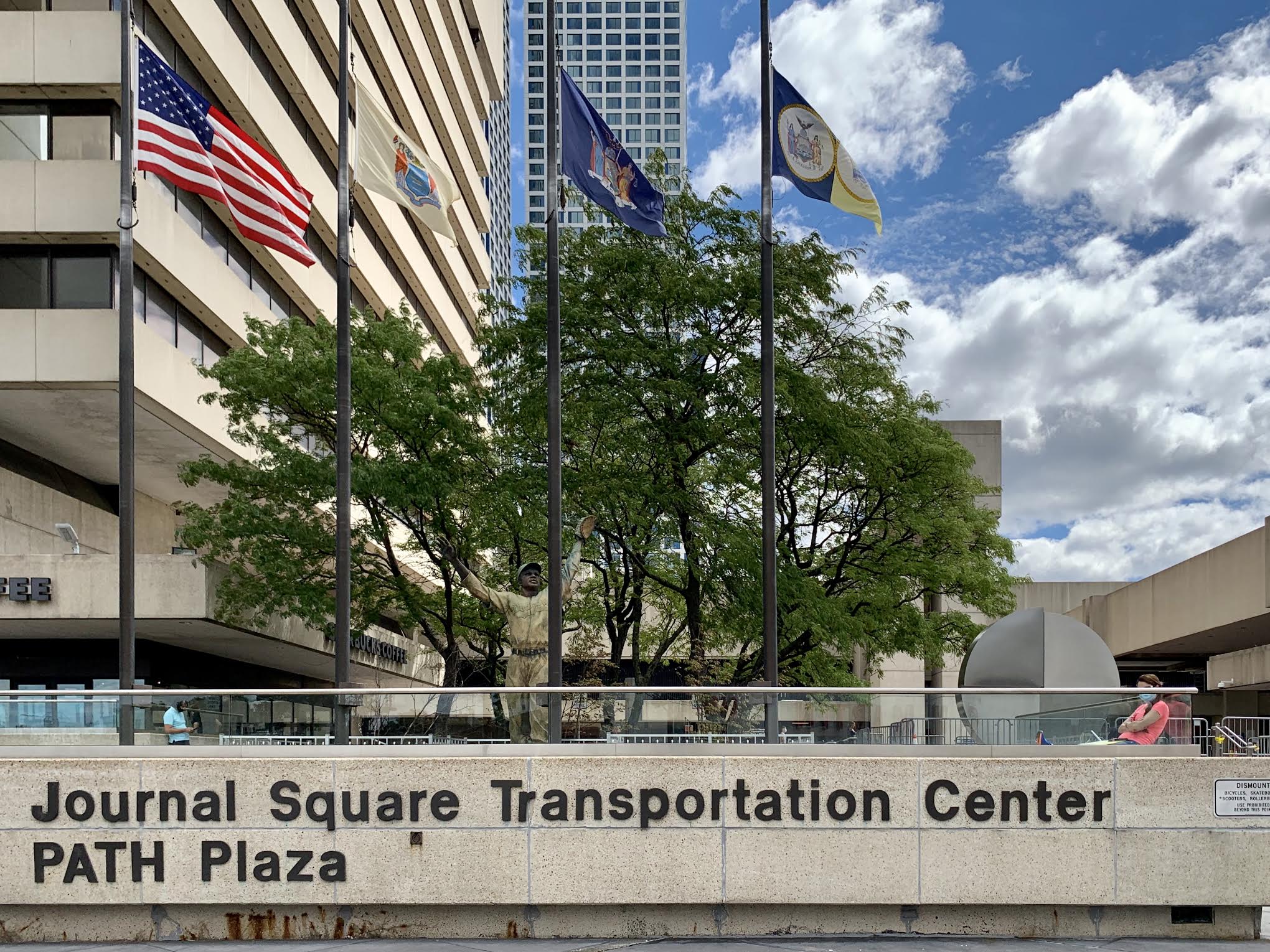
While Stop #1 may not seem historic, or even exciting, transport yourself back to April 14th, 1912 and imagine just how important the PATH transit hub would have been on its opening day. The Journal Square PATH Plaza houses multiple hubs of transportation, including the PATH train that operates the Journal Square–33rd Street {via Hoboken} and Newark-World Trade Center lines and a NJ Transit bus terminal. This transportation terminal is an integral piece of Hudson County history as it allowed passengers to travel to the waterfront and into Manhattan. The PATH Plaza is also home to the Port Authority of New York and New Jersey headquarters. Fun fact: when the PATH Plaza originally opened and until 1925, it was known as “Summit Avenue Station” of the Hudson and Manhattan Railroad.
Stop #2: Jackie Robinson Statue {1 PATH Plaza}
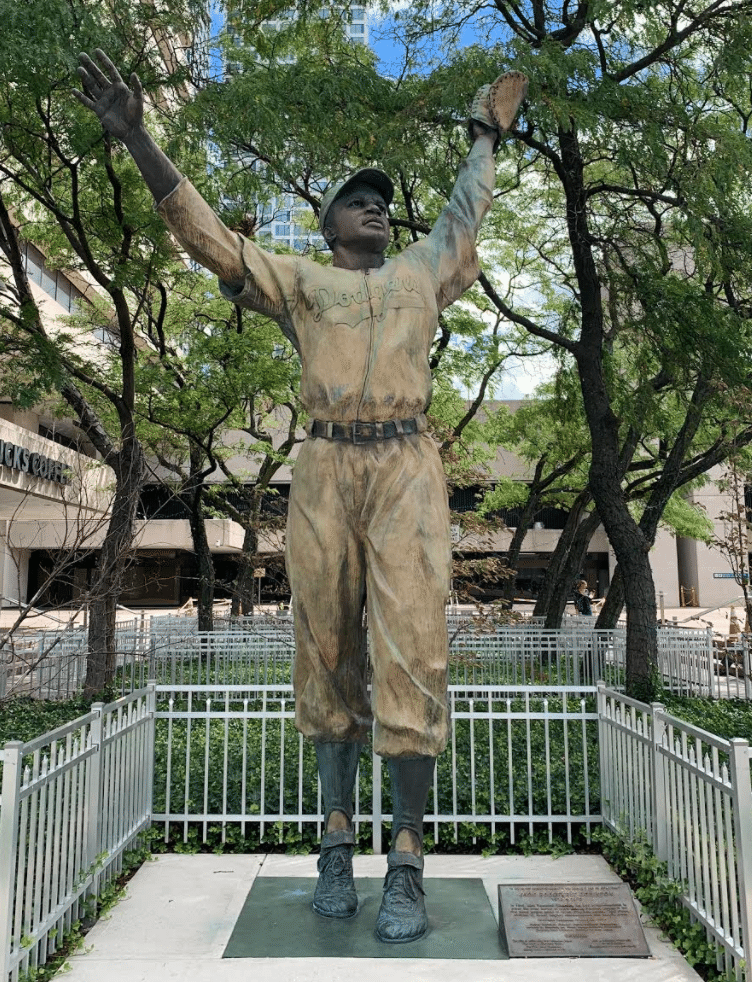
No need to leave Stop #1, just look around. Situated in the PATH Plaza you’ll find the Jackie Robinson statue.
Jackie Robinson was the first African-American man to play professionally in Major League Baseball. He started his career in the MLB for the Brooklyn Dodgers in 1947. But what links him specifically to Journal Square is that before he made it to the MLB, Jackie made his professional baseball debut on a triple AAA minor league team. His first-ever game as a Montreal Royal was at Roosevelt Field in Journal Square. Roosevelt Field was built in 1936 but demolished in 1982. It was the home field of local high school football and baseball teams, the Jersey City Giants {a farm team of the New York Giants} and even the Brooklyn Dodgers for a handful of games. Needless to say, the legendary Jackie Robinson statue in JSQ honors the player who broke barriers for not just the sport of baseball, but all sports. The statue was crafted by a sculptor by the name of Susan Wagner and dedicated on February 26th, 1998 by the Jackie Robinson Foundation, in partnership with the city of Jersey City, the New Jersey Sports History Commission, the Port Authority, and others. The 14 foot tall, bronze statue has an inscription that reads: “A life is not important except in the impact it has on other lives.”
Stop #3: The Stanley Theatre {2932 Kennedy Boulevard}
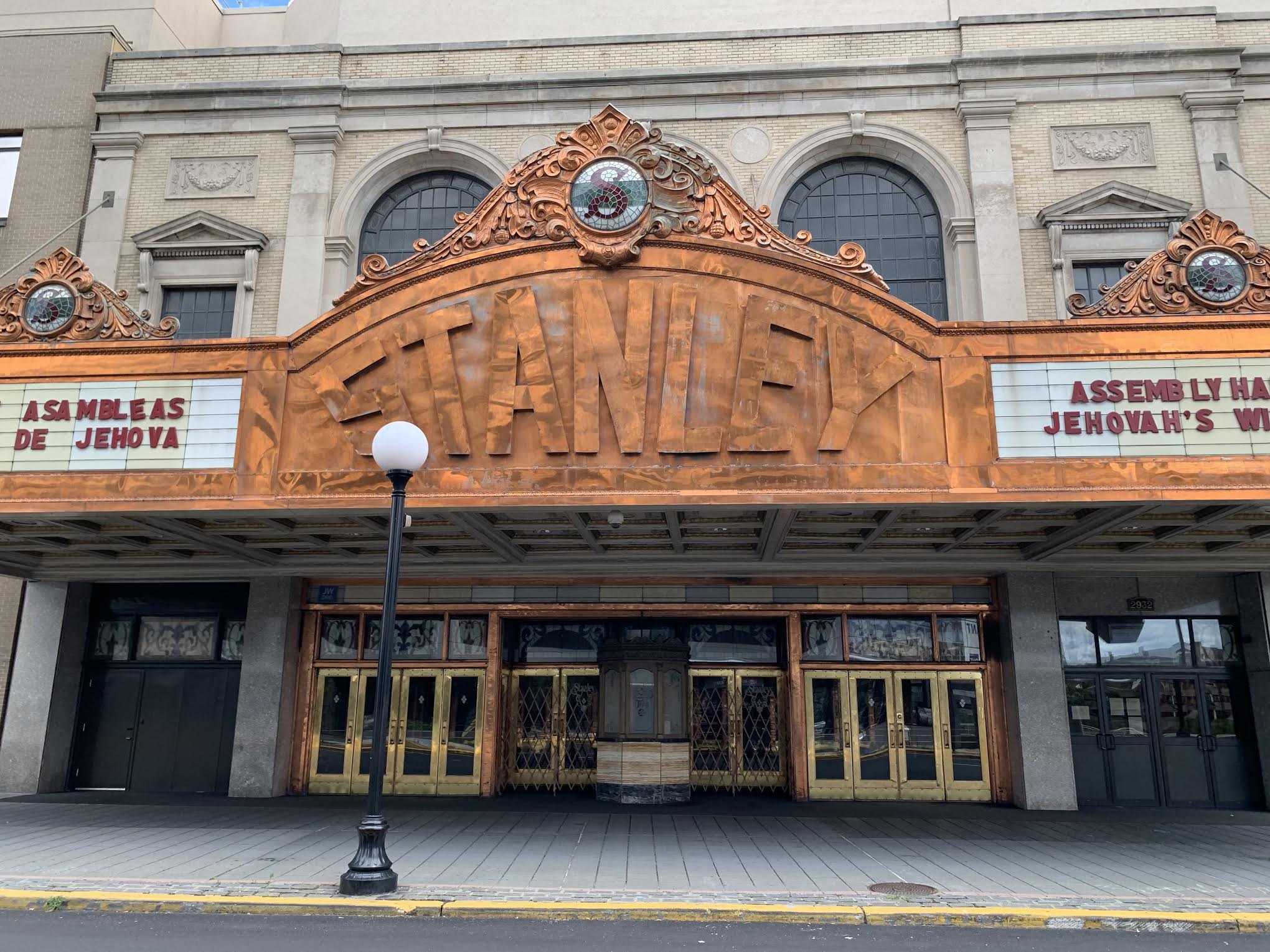
There are two theaters in the neighborhood, but thankfully their names are quite visible on each building. Look for the theater with a copper facade, and you’ll find The Stanley Theater.
The Stanley Theater was built in 1928 to serve as a movie house and “vaudeville,” which is defined as “a type of entertainment popular in the U.S. in the early 20th century, featuring a mixture of specialty acts such as burlesque comedy and song and dance.” The theater was built in the classic Gothic-style and is a massive structure. The interior of the building is said to be quite extravagant — with a copper marquee greeting you at the entrance, followed by a grand staircase and impressive chandeliers. In fact, the largest chandelier in the home is from New York’s original Waldorf Astoria of the 1880s. The Stanley Theater has welcomed performers like The Three Stooges, Tony Bennett, Janis Joplin, Dolly Parton, and the Grateful Dead to its stage until the theater closed in 1978. Since 1983, the Theater has been owned by the Watch Tower Society for use as a Jehovah’s Witness Convention Hall.
Stop #4: The Landmark Loew’s Jersey Theatre {54 Journal Square}
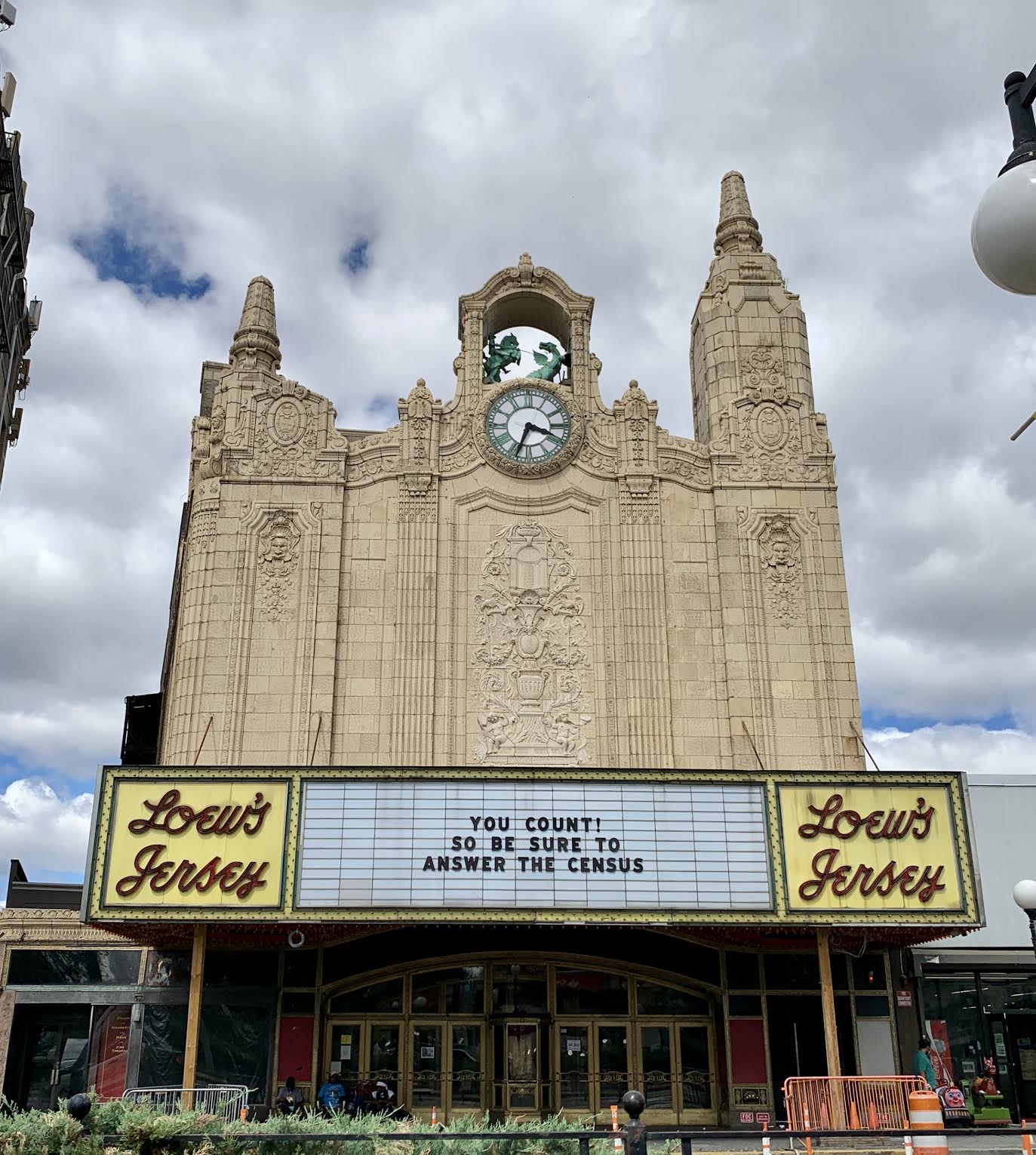
Off to the next theater, back past the PATH Plaza, we go!
The Loew’s Jersey Theater opened on September 28th, 1929, and was founded by Marcus Loew, who was also one of the founders of the {quite famous} MGM Studios. The ornate decor and structure of the building made for a $2MM investment and was what Loew considered one of his five “Wonder Theaters” in the New York City area for its grandiosity. The first show to ever play at the Loew’s Jersey Theater was Madame X, a live musical about a mother yearning to reunite with her son. Tickets cost only $0.35! Past and present, the Loew’s Theater is committed to showcasing a diverse set of programming, both film and stage performances, that speak to varying generations and cultures in the Hudson County community. In 1986, the Theater closed indefinitely. In 1993, it was purchased by an organization known now as “Friends of the Loews,” which relies on the help of volunteers to preserve and maintain the beauty of the space. In addition to showcasing movies and films, the Loew’s Theater has become the home of the Golden Door Film Festival, acts as a venue for corporate and fundraising events, and occasionally invites musicians to perform on their stage. Check out our article highlighting the Loew’s Theater after it celebrated its 90th-anniversary last year. According to recent news, Jersey City is moving forward on a $40 million renovation of the Theater, who is currently seeking a commercial operator.
Stop #5: Boulevard Drinks {48 Journal Square Plaza}
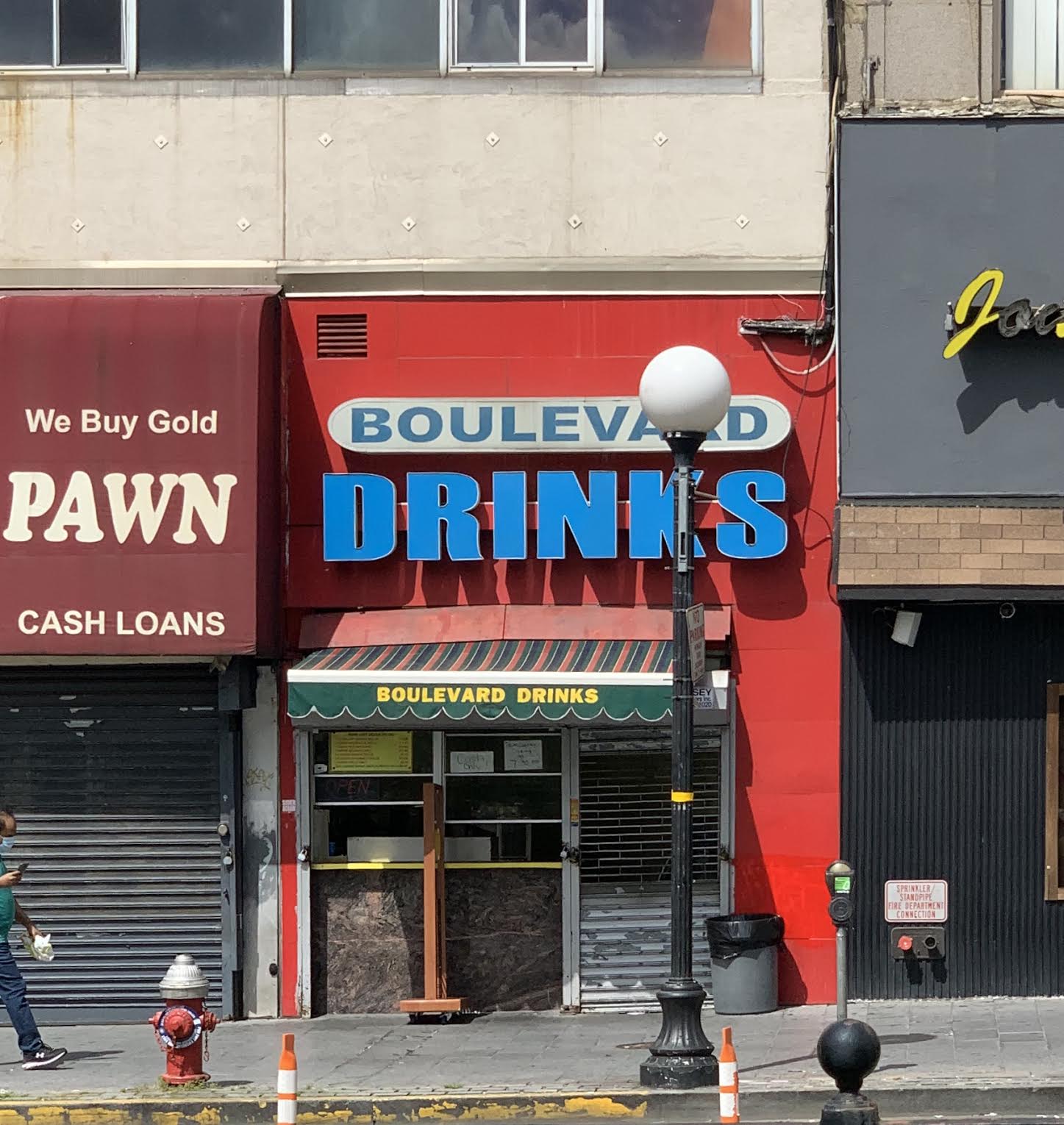
Hop, skip or dance your way over from Stop #4 next door, and make sure you arrive on an empty stomach.
Arguably the most delicious piece of Journal Square history lies on the corner of Kennedy Boulevard and Bergen Avenue, just across the street from the PATH plaza. Boulevard Drinks has been serving up award-winning hot dogs to its loyal customers since 1937. That’s 83 years! This local and historical spot is known for its chili dogs. The proof is in the pudding, or in this case, the hot dog.
Stop #6: Van Wagenen {Apple Tree} House {298 Academy Street}
Follow Bergen Avenue away from the PATH plaza. Make a right when you hit Academic Street and you’ll find Stop #6.
The Apple Tree House, also known as the Van Wagenen House, gained its name from the story of the 1780 meeting of General George Washington and Marquis de Lafayette during the American Revolution. Legends state that while camped in the village of Bergen for days, Washington and Lafayette dined in the yard of the house “underneath an apple tree” and discussed strategy for French naval intervention in the war. Today, it is currently used as office space for lectures, community meetings, and gatherings of the Jersey City Office of Cultural Affairs.
Read More: General Pencil Company: Pencil Makers in Jersey City Since 1889
Stop #7: Jersey City Armory {678 Montgomery Street}
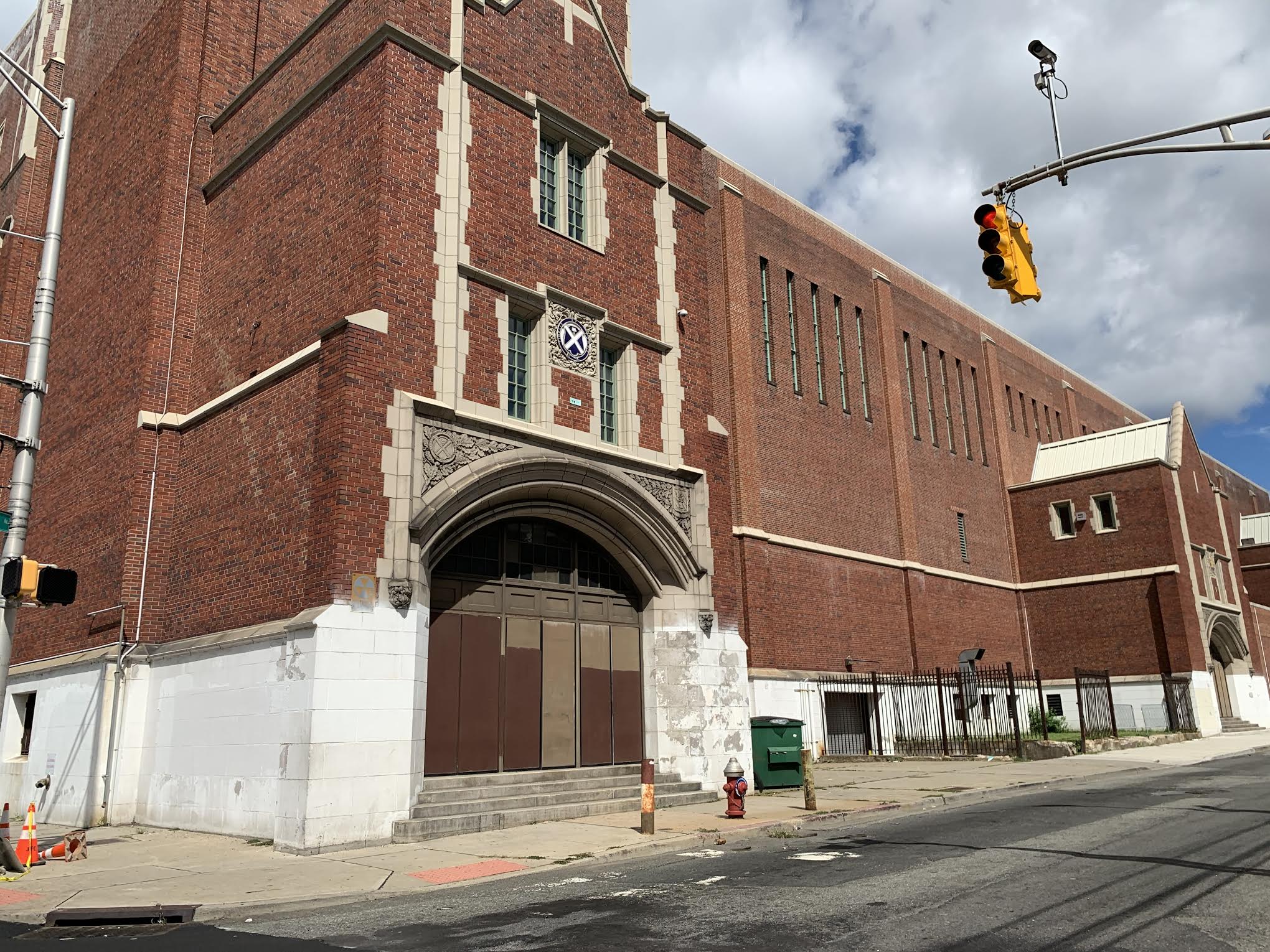
Walk back down Academic Street towards the Waterfront until you reach Summit Avenue. Make a right and walk until you hit Montgomery Street and stumble upon Stop #7 {it’s hard to miss}.
The Jersey City Armory is home to the New Jersey National Guard and was built in 1937 {interestingly enough, only one short year after Roosevelt Stadium was built}. The armory also operates as a sports arena for high school and collegiate levels, most often for track and field, basketball, boxing, and mixed martial arts. A few fun facts: The Jersey City Armory was the home court for the New Jersey Nets inaugural season. Due to its massive size {175,000 square feet}, the Armory was often used as a film studio. A Bronx Tale {1993} filmed scenes there!
Stop #8: Jersey City and Harismus Cemetery {435 Newark Avenue}
Walk uptown on Summit Avenue and make a right when you reach Magnolia Avenue.
The historic Jersey City and Harsimus Cemetery was created in 1829, although its historical significance draws back even further. The land is said to have been the site of battles of the Revolutionary War in the 1700s, and even an active Ammunition Bunker {which is still proudly standing on the grounds of the property} during the War of 1812. According to the website, the cemetery is the final resting place of thousands who lost their lives in the Revolutionary & Civil Wars, the War of 1812, the Spanish-American War, WWI, and WW II, forward, as well as home to our earliest Jersey City founders, leaders, residents, and legends. While the property had been neglected and abandoned for quite some time, in early 2008 a volunteer Board of Trustees was formed to maintain and preserve the cemetery. Earlier this year, NJ.com shared a wonderful story about the cemetery’s live-in caretaker, John Wilson, who has transformed the ground’s gardens from ruins to a thriving community space over the past 10 years in his role.
Stop #9: William L. Dickinson High School {2 Palisades Avenue}
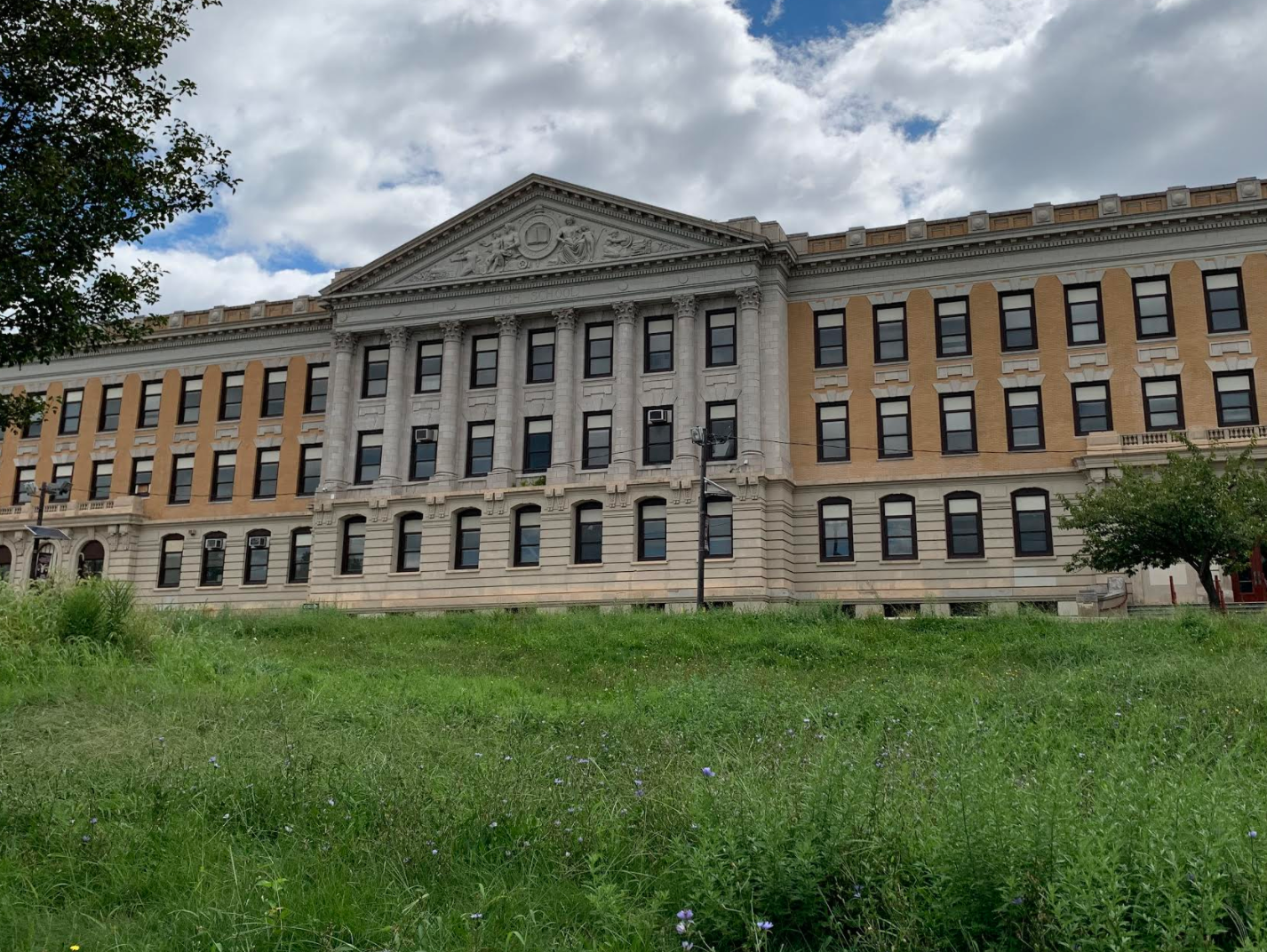
From Stop #8, follow Newark Avenue until it hits Palisade Avenue and you’ll spot Stop #9.
Once called Jersey City High School, the monstrosity of a building opened its doors to students on September 6th, 1906 for the first time. At the time, local politicians pushed for the school’s opening in an effort to help alleviate a major city issue— overcrowded public schools. The school was renamed to William L. Dickinson High School in 1913 to celebrate and pay homage to the superintendent who had advocated for the school’s opening during his term between 1872-1833. Famous events held in Dickinson High School’s original, 2,000 seat auditorium include a lecture by Helen Keller and political rallies for United States Presidents Taft, Wilson, and Roosevelt.
See More: The History of Dr. Martin Luther King Jr.’s Speeches in Jersey City
The school is three stories high and recognizable by its Corinthian-style columns in the front of the building. The property sits atop Bergen Hill and overlooks downtown Jersey City. According to New Jersey City University research, the land where the high school resides is known to have been an ideal vantage point used by George Washington during the Revolutionary War as it allowed him and his troops to observe British movements in Paulus Hook as well as across the Hudson River in lower Manhattan. In 1813, an arsenal was built on the property to protect the NY Harbor from potential destruction and to house a hospital for soldiers.
Stop #10: Hudson County Courthouse or William J. Brennan Courthouse {583 Newark Avenue}
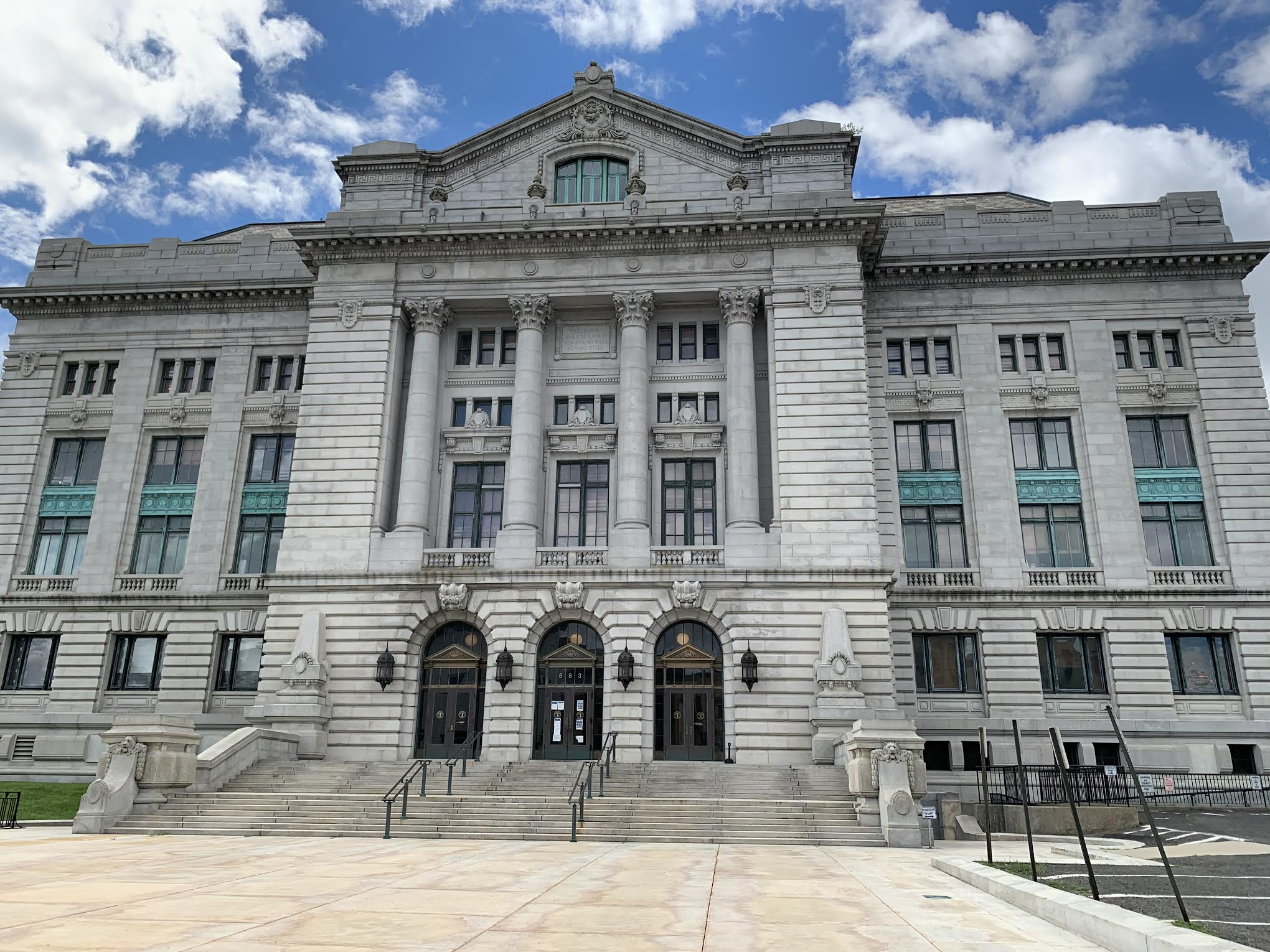
Continue walking uptown on Newark Ave from Stop #9 until this big building comes into sight.
The six-story tall Hudson County Courthouse opened on September 10th, 1910. The courthouse was used as the primary government house in Hudson County until the Hudson County Administration Building opened in 1966. As the story goes, the building was up for demolition after years of vacancy. But in 1970, the building was listed under the National Register of Historic places thanks to the work of volunteers. From there, restoration on the courthouse began. In 1984, The Hudson County Board of Chosen Freeholders voted to rename the building to honor Supreme Court Justice William J. Brennan Jr. Today, the courthouse has eight working courtrooms and holds the offices of the County Executive, the Hudson County Surrogate, and the Hudson County Bar Association. Fun fact: The courthouse has been filmed in multiple commercials, scenes in Law & Order, and The Joker!
Stop #11: Newkirk / Summit House {510 Summit Avenue}
Walk down Baldwin Avenue from Stop #10, and make a right onto Magnolia Avenue. From there, make your way to Summit Street. When you arrive at Newkirk House, you’ll find yourself just a block away from where we started at Stop #1: the JSQ Path Plaza.
Known to be the oldest surviving structure in Hudson County, the Newkirk House is a two-story Dutch Colonial-style home that dates back to 1960. The building stands just outside of the boundaries of the historic village of Bergen that was originally home to Dutch settlers. The Newkirk House was a piece of real estate that remained in the Newkirk family from 1659 until 1889, when John Newkirk and his son Jacob, Hudson County freeholders, sold the property. It was then used as an orphanage, and later as a slew of retail businesses. It wasn’t until 1979 that the Newkirk House was listed on the New Jersey Register of Historic Places. That same year, it became a restaurant known as the Summit House, which unfortunately closed in 2018. The building is vacant today.

